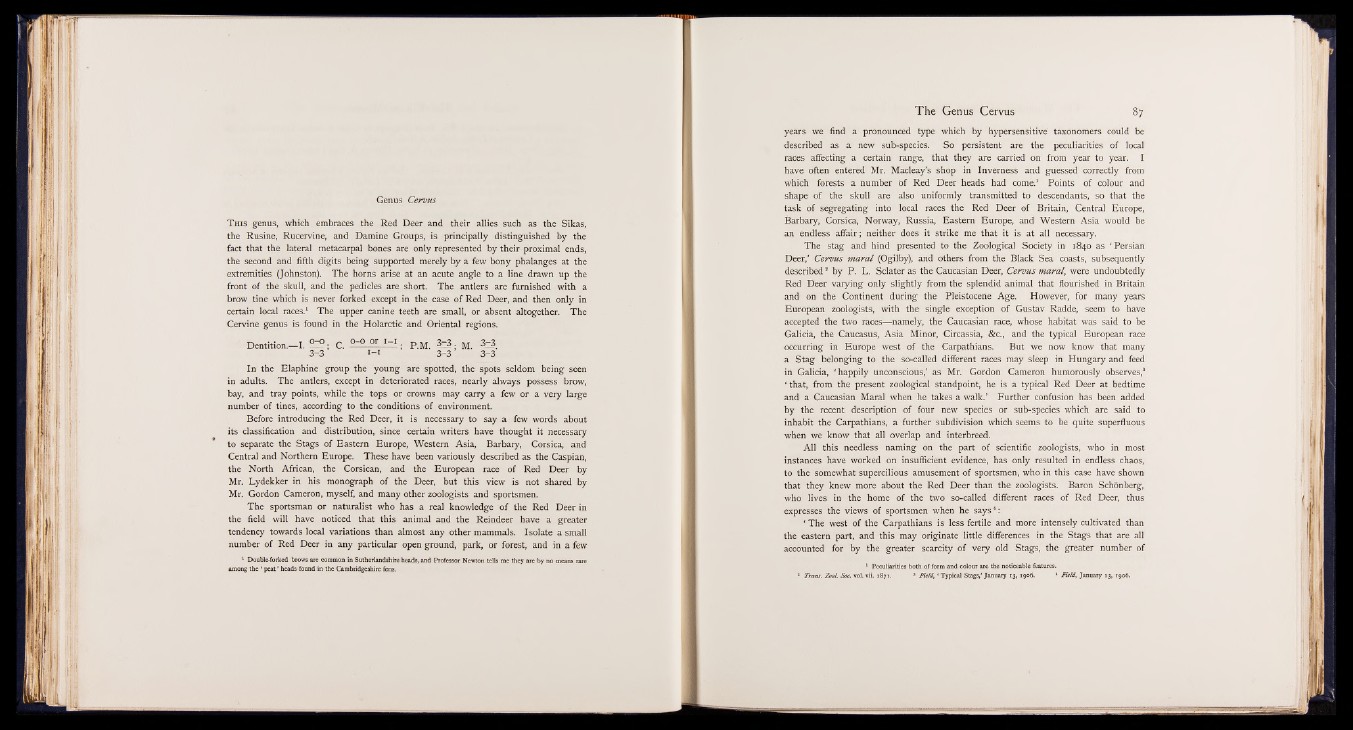
Genus Cervus
T h i s genus, which embraces the Red Deer and their allies such as the Sikas,
the Rusine, Rucervine, and Damine Groups, is principally distinguished by the
fact that the lateral metacarpal bones are only represented by their proximal ends,
the second and fifth digits being supported merely by a few bony phalanges at the
extremities (Johnston). The horns arise at an acute angle to a line drawn up the
front of the skull, and the pedicles are short. The antlers are furnished with a
brow tine which is never forked except in the case of Red Deer, and then only in
certain local races.1 The upper canine teeth are small, or absent altogether. The
Cervine genus is found in the Holarctic and Oriental regions.
Dentition.— I. — ; C. °~° or 1 3-3 - 1 ; P.M. 3=3. M 3-3 i - i 3-3 3-3
In the Elaphine group the young are spotted, the spots seldom being seen
in adults. The antlers, except in deteriorated races, nearly always possess brow,
bay, and tray points, while the tops or crowns may carry a few or a very large
number of tines, according to the conditions of environment.
Before introducing the Red Deer, it is necessary to say a few words about
its classification and distribution, since certain writers have thought it necessary
to separate the Stags of Eastern Europe, Western Asia, Barbary, Corsica, and
Central and Northern Europe. These have been variously described as the Caspian,
the North African, the Corsican, and the European race of Red Deer by
Mr. Lydekker in his monograph of the Deer, but this view is not shared by
Mr. Gordon Cameron, myself, and many other zoologists and sportsmen.
The sportsman or naturalist who has a real knowledge of the Red Deer in
the field will have noticed that this animal and the Reindeer have a greater
tendency towards local variations than almost any other mammals. Isolate a small
number of Red Deer in any particular open ground, park, or forest, and in a few
1 Double-forked brows are common in Sutherlandshire heads, and Professor Newton tells me they are by no means rare
among the ‘ peat ’ heads found in the Cambridgeshire fens.
years we find a pronounced type which by hypersensitive taxonomers could be
described as a new sub-species. So persistent are the peculiarities of local
races affecting a certain range, that they are carried on from year to year. I
have often entered Mr. Macleay’s shop in Inverness and guessed correctly from
which forests a number bf Red Deer heads had come.1 Points of colour and
shape of the skull are also uniformly transmitted to descendants, so that the
task of segregating into local races the Red Deer of Britain, Central Europe,
Barbary, Corsica, Norway, Russia, Eastern Europe, and Western Asia would be
an endless affair; neither does it strike me that it is at all necessary.
The stag and hind presented to the Zoological Society in 1840 as ‘ Persian
Deer,’ Cervus maral (Ogilby), and others from the Black Sea coasts, subsequently
described2 by P. L. Sclater as the Caucasian Deer, Cervus maral, were undoubtedly
Red Deer varying only slightly from the splendid animal that flourished in Britain
and on the Continent during the Pleistocene Age. However, for many years
European zoologists, with the single exception of Gustav Radde, seem to have
accepted the two races— namely, the Caucasian race, whose habitat was said to be
Galicia, the Caucasus, Asia Minor, Circassia, &c., and the typical European race
occurring in Europe west of the Carpathians. But we now know that many
a Stag belonging to the so-called different races may sleep in Hungary and feed
in Galicia, ‘ happily unconscious/ as Mr. Gordon Cameron humorously observes,3
‘ that, from the present zoological standpoint, he is a typical Red Deer at bedtime
and a Caucasian Maral when he takes a walk.’ Further confusion has been added
by the recent description of four new species or sub-species which are said to
inhabit the Carpathians, a further subdivision which seems to be quite superfluous
when we know that all overlap and interbreed.
All this needless naming on the part of scientific zoologists, who in most
instances have worked on insufficient evidence, has only resulted in endless chaos,
to the somewhat supercilious amusement of sportsmen, who in this case have shown
that they knew more about the Red Deer than the zoologists. Baron Schonberg,
who lives in the home of the two so-called different races of Red Deer, thus
expresses the views of sportsmen when he says4:
‘ The west of the Carpathians is less fertile and more intensely cultivated than
the eastern part, and this may originate little differences in the Stags that are all
accounted for by the greater scarcity of very old Stags, the greater number of
1 Peculiarities both of form and colour are the noticeable features.
* Trans. Zool. Soc. vol. vii. 1871. 3 Field, ‘ Typical Stags,’ January 13, r<)o6. * Field, January 13, 1906.